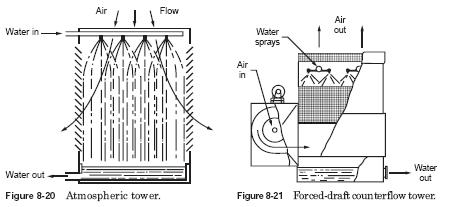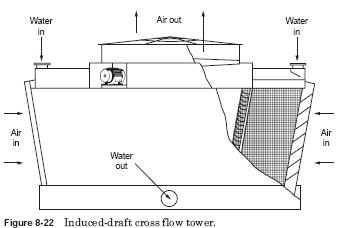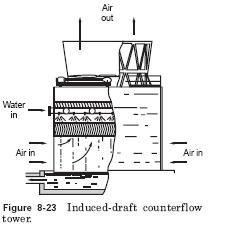Types Of Towers
Atmospheric tower type is not used mechalnical device, such as a fan to create airflow through the tower. There are two main types of atmospheric towers large and small. Large hyperbolic towers have to fill in because their main applications from power plants. The pair managed generator has a very high temperature steam to reduce to water, liquid, or gaseous. Atmospheric tower are relatively inexpensive. They are usually applied in very small sizes. They, as a rule, energy-intensive due to the high-pressure spraying needed. Atmospheric tower is much more susceptible to the adverse effects of wind conditions than other types. Their use in systems requiring accurate, reliable cold water temperature not reocmmended (see Fig. 8-20). 
Cooling towers, such as shown in Fig. 8-21, are classified as forced draft or induced draft.
In draught type of fan is located in the ambient air flow entering the tower. Air is also brought through or resulting from the entrance to the tower by a fan as shown in Fig. 8-22. In the induced-draft draws air through the towers. 
Forced draft have high air-speed input and low edit speeds. They are extremely sensitive to the recycling and therefore considered to have a lower performance, stability than forced draught. There are also concerns in the Northern climates as ventilators, located in cold input of ambient air stream can be the subject of severe icing. The resulting imbalance comes when the moving air, Laden with natural or recycling of moisture, becomes ice. Usually forced draught equipped with centrifugal fan type fans. These fans require about twice the operating horsepower propeller-type fans. They have the advantage of being able to work with high static pressures coming from the air ducts. So equipped, they can be installed indoors or in a specially designed case that provides sufficient separation between the air intake and discharge areas, to minimize the recirculation (see Fig. 8-23). 
..
|



